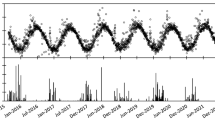Abstract
This paper presents the findings of the effect of some selected deficit irrigation scheduling practices on irrigated maize crop in a sub-catchment in south western part of Tanzania. Field experiments, in which maize (TMV1-ST) variety was planted under total irrigation, were conducted during the dry seasons of 2004 and 2005. Surface irrigation method was used and the crop was planted in basins. The seasonal water applied ranged from 400 to 750 mm. Soil moisture content from both cropped and bare soils, leaf area index, dry matter, and grain yields were measured. The dry matter yield ranged between 6,966 and 12,672 kg/ha, and grain yields obtained were between 1,625 and 4,349 kg/ha. The results showed that deficit irrigation at any crop growth stage of the maize crop led to decrease in dry matter and grain yields, seasonal evapotranspiration and deep percolation. Deficit irrigation in any one growth stage of the maize crop only seems to affect grain production and no significant effect on biomass production, but deficit irrigation that spanned across two or more growth stages affect both biomass and grain production drastically. Crop water use efficiency (WUE) and Irrigation water use efficiency (IWUE) were strongly influenced by the number of growth stages in which deficit irrigations were applied and how critical the growth stages were to moisture stress rather than the amount of irrigation water applied. While maximum WUE was obtained under full irrigation, maximum IWUE was obtained in the deficit irrigation treatment at vegetative growth stage, which suggest that IWUE may be improved upon by practicing deficit irrigation at the vegetative growth stage of the maize crop.




Similar content being viewed by others
References
Andrén U (ed). (1993) Breed and seed production in Zambia. A publication of the Department of Agriculture, Ministry of Agriculture, Food and Fisheries and the Zambia Seed Company Limited, Lusaka, 43pp
ARI-UYOLE (2002) Southern highlands zonal research progress report for 2001/2002. Tanzania agricultural research project II. The United Republic of Tanzanian Ministry of Agriculture and Cooperatives, Tanzania, 256pp
Cooper PJM, Keatinge JDH, Hughes G (1983) Crop evapotranspiration- a technique for calculation of its components by field measurements. Field Crops Res 7:299–312
De Costa WAJM, Shanmugathasan KN (2002) Physiology of yield determination of soybean under different irrigation regimes in the sub-humid zone of Sri Lanka. Field Crops Res 75:23–35
Doorenbos J, Kassam AH (1979) Yield response to water. FAO irrigation and drainage paper No. 33. FAO, Rome, 193 pp
English M (1990) Deficit irrigation I: analytical framework. J Irrig Drain Eng 116(3):399–410
English M, Raja SN (1996) Perspectives on deficit irrigation. Agric Water Manage 32:1–14
English MJ, Musick JT, Murty VVN (1990) Deficit irrigation. In: Hoffman GJ et al (eds) Management of farm irrigation systems. ASAE/Texas Agricultural Extension Service, St Joseph/Midland, pp 631–663
FAO (2002) Deficit irrigation practice. Water reports no. 22, Food and Agriculture Organisation of the United Nations, Rome, 100pp
Flénet F, Bouniols A, Saraiva C (1996) Sunflower response to a range of soil moisture content. Euro J Agron 5:161–167
Howell TA, Cuenca RH, Solomon KH (1990) Crop yield response. In: Hoffman GJ et al (eds) Management of farm irrigation systems. ASAE, St. Joseph, pp 93–122
Howell TA, Yazar A, Schneider AD, Dusek DA, Copeland KS (1995) Yield and water use efficiency of corn in response to LEPA irrigation. Trans ASAE 38:1737–1747
Howell TA, Tolk JA, Arland DS, Evertt R (1998) Evapotranspiration, yield and water use efficiency of corn hybrid differing in maturity. Agron J 90:3–9
Hsaio TC (1990) Measurement of plant water status. Annu Rev Plant Physiol 24:519–570
Ibragimov N, Evett SR, Esanbekov Y, Kamilov BS, Mirzaev L, Lamers JPA (2007) Water use efficiency for irrigated cotton in Uzbekistan under drip and furrow irrigation. Agric Water Manage 90:112–120
Jalota SK, Sood A, Chahal GBS, Choudhary BU (2006) Crop water productivity of cottons (Gossypium hirsutum L.) and wheat (Triticum aestivum L.) system as influenced by deficit irrigation, soil texture, and precipitation. Agric Water Manage 84:137–146
James LG (1988) Principles of farm irrigation system design. Wiley, New York
Jamieson PD, Martin RJ, Francis GS, Wilson DR (1995) Drought effects on biomass yield production and radiation use efficiency in barley. Field Crops Res 43:77–86
Karam F, Lahoud R, Masaad R, Kabalam R, Breidi J, Chalita C, Rouphael Y (2007) Evapotranspiration, seed yield and water use efficiency of drip irrigated sunflower under full and deficit irrigation conditions. Agric Water Manage 90:213–223
Kirda C (2002) Deficit irrigation scheduling based on plant growth stages showing water stress tolerance. In: Deficit irrigation practice. Water reports 22. FAO, Rome, pp. 1–3
Koksal H, Kanber R (1998) Water-yield relations on second crop maize under Cukurova conditions. In: Symposium on agriculture and forest meteorology 98, ITU, Istanbul, 21–23 October, pp 310–317
Lamm FR, Manges LR, Stone LR, Khan AH, Roger DH (1995) Water requirement of subsurface drip irrigated corn in North-West Kansas. Trans ASAE 38:441–448
Martin DL, Stegman EC, Freres E (1990) Irrigation scheduling principals. In: Hoffman GL, Howell TA, Solomon KH (eds) Management of farm irrigation systems. ASAE Monograph, St. Joseph, pp 155–372
Michael AM (1999) Irrigation theory and practice (reprint). Vikas Publishing House PVT Ltd, New Delhi
Musick LT, Dusek DA (1980) Irrigated corn yield response to water. Trans ASAE 23:92–98
Oktem A, Simsek M, Oktem AG (2003) Deficit irrigation effects on sweet corn (Zea mays saccharata Sturt) with drip irrigation system in a semi-arid region. I. Water-yield relationship. Agric Water Manage 61:63–74
Otegui ME, Andrade FH, Suero EE (1995) Growth, water use, and kernel abortion of maize subjected to drought at silking. Field Crops Res 40:87–94
Pandey RK, Maranville JW, Admou A (2000) Deficit irrigation and nitrogen effects on maize in a sahelian environment I. Grain yield and yield components. Agric Water Manage 46:1–13
Prichard T, Hanson B, Schwankl L, Verdegaal P, Smith R (2004) Deficit irrigation of quality wine grapes using micro-irrigation techniques. Publications of University of California Co-operative Extension, Department of Land, Air and Water Resources, University of California, Davis, 5pp
Rhoades FM, Bennett JM (1990) Corn. In: Stewart BA, Nielsen DR (eds) Irrigation of agricultural crops. Agronomy Monograph 30. ASA, CSSA and SSSA, Madison, pp 569–596
Ritchie SW, Hanway JJ (1982) How a crop plant develops. Special report 48. Iowa State University Cooperative Extension Services, Ames, 12pp
Singh BR, Singh DP (1995) Agronomic and physiological responses of sorghum, maize and pearl millet to irrigation. Field Crops Res 42:57–67
Smith M, Kivumbi D, Heng LK (2002) Use of the FAO CROPWAT model in deficit irrigation studies. In: Deficit irrigation practice. Water reports no. 22. Food and Agriculture Organisation of the United Nations, Rome, pp 17–28
Stegman EC, Musick JT, Stewart JI (1980) Irrigation water management. In: Jensen ME (ed) Design and operation of farm irrigation systems. ASAE Monograph No. 3, ASAE, St. Joseph, pp 763–816
Stone LR, Schlegel AJ, Gwin RE, Khan AH (1996) Response of corn, grain sorghum, and sunflower to irrigation in the High Plains of Kansas. Agric Water Manage 30:251–259
Stone PJ, Wilson DR, Beid JB, Gillespie RN (2001) Water deficit effects on sweet corn I. water use, radiation use efficiency, growth, and yield. J Agric Res 52:103–113
SWMRG-FAO (2003) Comprehensive assessment of water resources of Mkoji sub catchment, its current uses and productivity. FAO- Netherlands Partnership Programme, Water and Food Security. IWRM for the Vulnerable Group, PR26935. 50pp
Tolk JA, Howell TA (2003) Water use efficiency of grain sorghum in three USA Southern Great Pains Soils. Agric Water Manage 59:97–111
Viets FG Jr (1962) Fertilizer and the efficient use of water. Adv Agron 14:223–264
Wang HX, Zhang L, Dawes WR, Liu CM (2001) Improving water use efficiency of irrigated crops in the North China Plain—measurements and modelling. Agric Water Manage 48:151–167
Yang HS, Dobermann A, Lindquist JL, Walker DT, Arkebauer TJ, Cassman KG (2004) Hybrid-maize- a maize simulation model that combines two crop modelling approaches. Field Crops Res 87:131–154
Yazar A, Howell TA, Dusek DA, Copeland KS (1999) Evaluation of crop water stress index for LEPA irrigated corn. Irrig Sci 18:171–180
Zhang X, You M, Wang X (1999) Effects of water deficits on winter wheat yield during its different development stages. Acta Agric Boreali-Sin 14:79–83
Zhang Y, Yu Q, Liu C, Jiang J, Zhang X (2004) Estimation of winter wheat evapotranspiration under water stress with to semi-empirical approach. Agron J 96:159–168
Author information
Authors and Affiliations
Corresponding author
Additional information
Communicated by T. Trooien.
Rights and permissions
About this article
Cite this article
Igbadun, H.E., Salim, B.A., Tarimo, A.K.P.R. et al. Effects of deficit irrigation scheduling on yields and soil water balance of irrigated maize. Irrig Sci 27, 11–23 (2008). https://doi.org/10.1007/s00271-008-0117-0
Received:
Accepted:
Published:
Issue Date:
DOI: https://doi.org/10.1007/s00271-008-0117-0




